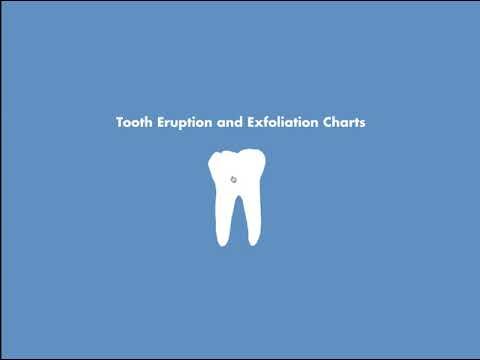Ultimate Guide to Baby Teeth Chart

If you've ever wondered when your little one's first tooth might make its appearance, you're not alone. Understanding the timeline for baby teeth eruption can help parents prepare for the teething stage and know what to expect as their child grows. From the first adorable toothless grin to the full set of pearly whites, a baby teeth chart can be a valuable tool for tracking your child's dental development. Let's take a closer look at the typical sequence and timing of baby teeth eruption, so you can be better prepared for this exciting milestone in your child's early years.
What is the typical sequence of baby teeth eruption?
The normal order of baby teeth follows a specific pattern, starting from the front of the mouth and moving towards the back. The first teeth to come in are the bottom central incisors, followed by the top central incisors. Next in line are the lateral incisors, then the first molars, and finally the canines. The last to come in are the second molars, completing the set of 20 baby teeth.
Teething typically begins around 6 months of age and can last until a child is around 2 to 3 years old. During this time, children may experience discomfort and irritability as their teeth break through the gums. It is important for parents to provide relief through teething toys, cold washcloths, or gentle massages on the gums to help soothe their little ones during this stage.
Understanding the normal order of baby teeth can help parents anticipate when their child's teeth will come in and monitor their dental development. Regular dental check-ups with a pediatric dentist can ensure that baby teeth are growing in properly and address any concerns early on. As children grow, their baby teeth will eventually be replaced by permanent teeth, making it essential to establish good oral hygiene habits from a young age.
What is the timeline for tooth eruption?
The timeline for tooth eruption typically begins with the lower and upper central incisors between the ages of 6-12 months, followed by the lateral incisors between 9-16 months. The first molars usually come in between 13-19 months, with the cuspids (canines) following suit from 16-23 months.
What are the earliest teeth in babies?
Babies typically start teething around 3 months old, with the first teeth usually emerging between 4 and 7 months of age. The initial teeth to break through are usually the two bottom front teeth, known as the central incisors.
Everything You Need to Know About Baby Teeth
Baby teeth, also known as primary teeth, play a crucial role in a child's development. These teeth not only help with chewing and speaking, but they also guide the permanent teeth into their proper positions. It is important to care for baby teeth by brushing them twice a day and scheduling regular dental check-ups to prevent decay and ensure proper growth. Additionally, understanding the timeline of when baby teeth typically erupt and fall out can help parents track their child's oral health progress. By taking proactive steps to maintain baby teeth, parents can set their children up for a lifetime of healthy smiles.
A Comprehensive Baby Teeth Development Timeline
Babies begin teething around 6 months old, with their first tooth typically appearing on the lower front gums. Over the next few years, a full set of 20 baby teeth will emerge, with the last ones usually coming in around age 2 or 3. It's important for parents to care for these tiny teeth by gently brushing them as soon as they appear and scheduling regular dental check-ups to ensure proper development.
As children grow, their baby teeth will gradually fall out to make way for permanent adult teeth. This process usually starts around age 6 and continues until the early teenage years. By understanding the timeline of baby teeth development, parents can better anticipate when to expect changes in their child's smile and promote good oral hygiene habits from an early age.
Understanding Your Child's Dental Milestones
As a parent, it is important to understand your child's dental milestones in order to ensure their oral health. From the eruption of their first tooth to the loss of their baby teeth and the growth of permanent teeth, each stage plays a crucial role in their overall dental development. By staying informed and proactive about your child's dental health, you can help them establish good oral hygiene habits that will benefit them for a lifetime. Regular visits to the dentist, proper brushing and flossing techniques, and a balanced diet are all key components in maintaining a healthy smile for your child.
The Essential Guide to Tracking Baby Teeth Growth
Are you a new parent or caregiver looking to track your baby's tooth growth? Look no further than The Essential Guide to Tracking Baby Teeth Growth. This comprehensive guide provides everything you need to know about your baby's dental development, from the arrival of the first tooth to the shedding of the last baby tooth. With easy-to-follow charts and helpful tips, you'll be able to monitor your little one's dental milestones with confidence.
Say goodbye to guessing when your baby's teeth are supposed to come in and hello to The Essential Guide to Tracking Baby Teeth Growth. This must-have resource offers a clear and concise roadmap for understanding and monitoring your baby's dental journey. With its user-friendly format and expert advice, you'll be equipped to navigate the exciting world of baby tooth growth with ease.
In summary, understanding the baby teeth chart is essential for parents to monitor their child's dental development and ensure proper oral care from a young age. By familiarizing themselves with the timeline of tooth eruption and loss, caregivers can proactively address any concerns and establish healthy dental habits that will benefit their child's overall well-being in the long run. Remember, a bright smile starts with healthy baby teeth.